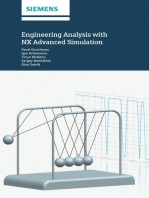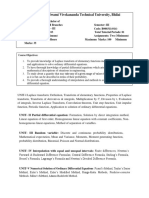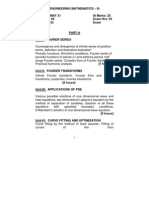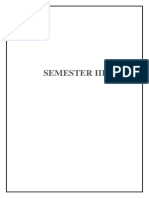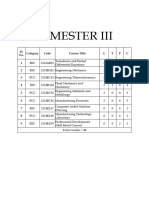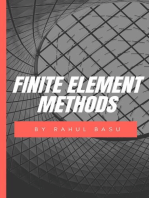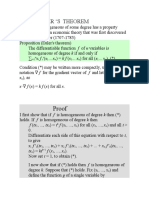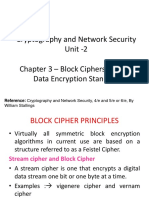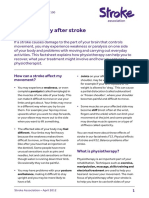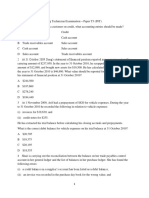Course Structure
Uploaded by
21-390Virkula Manish goud GNITC LEMECHCourse Structure
Uploaded by
21-390Virkula Manish goud GNITC LEMECHGURU NANAK INSTITUTIONS TECHNICAL CAMPUS
(An UGC Autonomous Institution - Affiliated to JNTUH)
Ibrahimpatnam, Ranga Reddy District, Hyderabad - 501 506 .
Department of Mechanical Engineering
GNITC - Regulation - R18
COURSE STRUCTURE
AND
DETAILED SYLLABUS
for
II YEAR B.TECH. - I SEMESTER
MECHANICAL ENGINEERING
(Applicable for the batches admitted from 2018-19)
GURU NANAK INSTITUTIONS TECHNICAL CAMPUS
(An UGC Autonomous Institution - Affiliated to JNTUH)
1 | GURU NANAK INSTITUTIONS TECHNICAL CAMPUS B.Tech. Mech. R18
Ibrahimpatnam, Ranga Reddy District, Hyderabad - 501 506 .
Department of Mechanical Engineering
COURSE STRUCTURE
(Applicable from the batch admitted during 2018-19 and onwards)
II YEAR B.TECH. ME - I SEMESTER
Hours per Week
S. No Group Course Code Course Title Credits
L T P
1 BSC 18BS0MA03 Mathematics-III 3 1 0 4
2 PCC 18PC0ME01 Classical Engineering Mechanics 3 1 0 4
3 PCC 18PC0ME02 Material Science & Metallurgy 3 0 0 3
4 PCC 18PC0ME03 Thermodynamics 3 1 0 4
5 PCC 18PC0ME04 Production Technology 3 0 0 3
6 PCC 18PC0ME05 Production Technology Lab 0 0 2 1
7 PCC 18PC0ME06 Machine Drawing Practice 1 0 3 2
8 PCC 18PC0ME07 Thermodynamics Lab 0 0 2 1
9 MC 18MC0EN01 Constitution of India 3 0 0 0
Total Credits 22
II Year B.Tech. Mech. I - Sem L T P C
3 1 0 4
2 | GURU NANAK INSTITUTIONS TECHNICAL CAMPUS B.Tech. Mech. R18
(18BS0MA03) MATHEMATICS-III
Course Objectives:
1. To learn the concepts & properties of Random variables and Probability distributions.
2. To learn the concepts of correlations and regressions.
3. To understand Concepts & properties of the testing of hypothesis for large & small samples.
4. To provide basic concepts of Complex functions and properties.
5. To learn the basic concepts of Conformal & Bilinear Transformations.
Course Outcomes:
At the end of the course, the student will be able to:
1. Identify the random variables involved in the probability models.
2. Calculate the Correlation and linear regression for a given data set.
3. Apply various statistical tests in testing of Hypothesis on the given data.
4. Evaluation of integrals by using Cauchy’s integral theorem & formula.
5. Understanding the concepts of Conformal & Bilinear transformations.
UNIT-I: Random variables and probability distributions.
Random variables – Discrete and continuous. Probability distributions, mass function/ density function of
a probability distribution. Mathematical Expectation, Moment generating function of probability
distribution. Binomial, Poisson & normal distributions and their properties .
UNIT-II: Multiple Random variables, Correlation & Regression
Joint probability distributions- Joint probability mass / density function, Marginal probability mass /
density functions, Covariance of two random variables, Correlation -Coefficient of correlation, The rank
correlation, Regression- Regression Coefficient, The lines of regression.
UNIT-III: Sampling Distributions and Testing of Hypothesis
Sampling: Definitions of population, sampling, statistic, parameter. Types of sampling, expected values
of Sample mean and variances, sampling distribution, Standard error, Sampling distribution of means and
sampling distribution of variances.
Testing of hypothesis: Null hypothesis, Alternate hypothesis, type I, & type II errors – critical region,
confidence interval and Level of significance. One sided test, Two-sided test,
Large sample tests:
Test of Equality of means of two samples equality of sample mean and population mean
Small sample tests:
Student t-distribution, its properties; Test of significance difference between sample mean and population
mean
UNIT-IV: Functions of Complex Variables
Complex functions and its representation on Argand plane, Concepts of limit Continuity, Differentiability,
Analyticity, and Cauchy-Riemann conditions, Harmonic functions – Milne – Thompson method.
Line integral – Evaluation along a path and by indefinite integration – Cauchy’s integral theorem –
Cauchy’s integral formula – Generalized integral formula.
UNIT – V: Conformal mapping
Power series expansions of complex functions: Radius of convergence – Expansion in Taylor’s sries and
Maclaurin’s series and Laurent series. Singular point – Isolated singular point - pole of order m –
essential singularity. Residues- Residue theorem.
3 | GURU NANAK INSTITUTIONS TECHNICAL CAMPUS B.Tech. Mech. R18
Residue – Evaluation of residue by formula and by Laurent series – Residue theorem.
Conformal mapping.
Transformation of z-plane to w-plane by a function, Conformal transformation. Standard transformations-
Translation; Magnification and rotation; inversion and reflection, Transformations like e z , log z, z2, and
Bilinear transformation. Properties of Bilinear transformation, determination of bilinear transformation
when mappings of 3 points are
given.
Suggested Text/Reference Books
1. B S Grewal, Higher Engineering Mathematics, Khanna Publishers, 36th Edition, 2010.
2. Ramana B.V., Higher Engineering Mathematics, Tata McGraw Hill New Delhi, 11th Reprint, 2010.
3. Erwing kreyszig, Advanced Engineering Mathematics, 9th Edition, John Wiley & Sons, 2006.
4. G. B. Thomas and R. L. Finney, Calculus and Analytic Geometry, 9th Edition, Pearson, Reprint, 2002.
II Year B.Tech. Mech. I-Sem L T P C
3 1 0 4
4 | GURU NANAK INSTITUTIONS TECHNICAL CAMPUS B.Tech. Mech. R18
(18PC0ME01) CLASSICAL ENGINEERING MECHANICS
Course Objectives:
The objectives of this course are to
1. Explain the resolution of a system of forces, compute their resultant and solve problems using
equations of equilibrium
2. Perform analysis of bodies lying on rough surfaces.
3. Locate the centroid of a body and compute the area moment of inertia and mass moment of inertia of
standard and composite sections
4. Explain kinetics and kinematics of particles, projectiles, curvilinear motion, centroidal motion and
plane motion of rigid bodies.
5. Explain the concepts of work-energy method and its applications to translation, rotation and plane
motion and the concept of vibrations
Course Outcomes:
At the end of the course, students will be able to
1. Determine resultant of forces acting on a body and analyse equilibrium of a body subjected to a system
of forces.
2. Solve problem of bodies subjected to friction.
3. Find the location of centroid and calculate moment of inertia of a given section.
4. Understand the kinetics and kinematics of a body undergoing rectilinear, curvilinear, rotatory motion
and rigid body motion.
5. Solve problems using work energy equations for translation, fixed axis rotation and plane motion and
solve problems of vibration.
UNIT-I: Introduction to Engineering Mechanics - Force Systems: Basic concepts, Particle equilibrium in
2-D & 3-D; Rigid Body equilibrium; System of Forces, Coplanar Concurrent Forces, Components in
Space – Resultant- Moment of Forces and its Application; Couples and Resultant of Force System,
Equilibrium of System of Forces, Free body diagrams, Equations of Equilibrium of Coplanar Systems and
Spatial Systems; Static Indeterminacy
UNIT-II: Friction: Types of friction, Limiting friction, Laws of Friction, Static and Dynamic Friction;
Motion of Bodies, wedge friction, screw jack & differential screw jack;
Centroid and Centre of Gravity -Centroid of Lines, Areas and Volumes from first principle, centroid of
composite sections; Centre of Gravity and its implications. – Theorem of Pappus
UNIT-III: Area moment of inertia- Definition, Moment of inertia of plane sections from first principles,
Theorems of moment of inertia, Moment of inertia of standard sections and composite sections; Product
of Inertia, Parallel Axis Theorem, Perpendicular Axis Theorem
Mass Moment of Inertia: Moment of Inertia of Masses - Transfer Formula for Mass Moments of Inertia –
Mass moment of inertia of composite bodies.
UNIT-IV: Review of particle dynamics- Rectilinear motion; Plane curvilinear motion (rectangular, path,
and polar coordinates). 3-D curvilinear motion; Relative and constrained motion; Newton’s 2nd law
5 | GURU NANAK INSTITUTIONS TECHNICAL CAMPUS B.Tech. Mech. R18
(rectangular, path, and polar coordinates). Work-kinetic energy, power, potential energy. Impulse-
momentum (linear, angular); Impact (Direct and oblique).
UNIT-V: Kinetics of Rigid Bodies -Basic terms, general principles in dynamics; Types of motion,
Instantaneous centre of rotation in plane motion and simple problems; D’Alembert’s principle and its
applications in plane motion and connected bodies; Work Energy principle and its application in plane
motion of connected bodies; Kinetics of rigid body rotation
TEXT BOOKS:
1. Engineering Mechanics: Statics and Dynamics, 2006, 11th edition / K. M. Shames and I. H. Rao,
Pearson Education;
2. Singer’s Engineering Mechanics – Statics & Dynamics, 2010, 3rd Ed (SI Units) / Reddy Vijay Kumar
K. and J. Suresh Kumar, BSP Books Pvt Ltd.
REFERENCE BOOKS:
1. Engineering Mechanics, 1983, Fourth Edition, / Timoshenko S.P and Young D.H., McGraw Hill
International Edition.
2. Engineering Mechanics, 2014, 4th Edition / Andrew Pytel, Jaan Kiusalaas, Cengage Learning.
3. Mechanics for Engineers, 2004, 10th Edition / Ferdinand Beer and E. Russell Johnston, Jr. and David
Mazurek and Phillip Cornwell and Brian Self, TMH.
4. Engineering Mechanics, 2010, Fourteenth edition / Hibbeler R.C & Ashok Gupta, Pearson Education.
5. Engineering Mechanics – Statics & Dynamics, 2011 / Tayal A.K., Umesh Publications.
6. Engineering Mechanics, 2008 / Basudeb Bhattacharyya, Oxford University Press.
7. Engineering Mechanics, Volume-II, 2008 / Meriam. J. L. Dynamics, John Wiley & Sons.
II YEAR B.Tech. Mech. I-Sem L T P C
3 0 0 3
6 | GURU NANAK INSTITUTIONS TECHNICAL CAMPUS B.Tech. Mech. R18
(18PC0ME02) MATERIAL SCIENCE & METALLURGY
Pre-requisites:
Basic idea of bonding nature in solids and different properties of elements
Objectives:
Understand the crystal structure and classification of materials and determining mechanical properties and
their suitability for applications. Classify cast irons and study their applications. Interpret the phase
diagrams of materials. Select suitable heat-treatment process to achieve desired properties of metals and
alloys. Understand the ceramics and composite materials and their properties.
Course outcomes:
The student an able to understand basic idea of the different material properties and heat treatment process
of ferrous and non-ferrous alloys with respect to phase diagrams.
UNIT – I: Structure of Metals
Bonds in Solids – Metallic bond - crystallization of metals, grain and grain boundaries, effect of grain
boundaries on the properties of metal / alloys – determination of grain size.
Constitution of Alloys: Necessity of alloying, types of solid solutions, Hume Rotherys rules, intermediate
alloy phases, and electron compounds.
UNIT -II: Equilibrium Diagrams
Experimental methods of construction of equilibrium diagrams, Isomorphous alloy systems, equilibrium
cooling and heating of alloys, Lever rule, coring miscibility gaps, eutectic systems, congruent melting
intermediate phases, peritectic reaction. Transformations in the solid state – allotropy, eutectoid,
peritectoid reactions, phase rule, relationship between equilibrium diagrams and properties of alloys.
Study of important binary phase diagrams of Cu-Ni-, Al-Cu, Bi-Cd, Cu-An, Cu-Sn and Fe-Fe3C.
UNIT -III: Cast Irons and Steels
Structure and properties of White Cast iron, Malleable Cast iron, grey cast iron, Spheroidal graphite cast
iron, Alloy cast irons. Classification of steels, structure and properties of plan carbon steels, Low alloy
steels, Hadfield manganese steels, tool and die steels.
UNIT – IV: Heat treatment of Alloys
Effect of alloying elements on Fe-Fe3C system, Annealing, normalizing, Hardening, TTT diagrams,
tempering, Hardenability surface - hardening methods, Age hardening treatment, Cryogenic treatment of
alloys.
Non-ferrous Metals and Alloys: Structure and properties of copper and its alloys, Aluminium and its
alloys, Titanium and its alloys.
UNIT – V:
Ceramic materials: Crystalline ceramics, glasses, ceramets, abrasive materials, nanomaterials –
definition, properties and applications of the above.
Composite materials: Classification of composites, various methods of component manufacture of
composites, particle – reinforced materials, fibre reinforced materials, metal ceramic mixtures, metal –
matrix composites and C – C composites.
TEXT BOOKS:
1. Introduction to Physical Metallurgy, 1997, 2nd Edition / Sidney H. Avner, Mc Graw Hill India.
7 | GURU NANAK INSTITUTIONS TECHNICAL CAMPUS B.Tech. Mech. R18
2. Material Science and Metallurgy for Engineers, 2009, 25th Edition / Dr. V. D. Kodgire (Author), Sushil
V. Kodgire (Author), Everest Publishing House.
REFERENCE BOOKS:
1. Essential of Materials science and engineering, 3rd edition/ Donald R. Askeland, 2013 Thomson.
2.Science of Engineering Materials,1989, 1st edition / B.K. Agarwal, McGraw-Hill Professional.
3.Physical Metallurgy, 2011, 1st edition/ Vijendra Singh, Standard Publishers Distributors.
4. Elements of Material Science and Engineering, 2002, 6th Edition / V. Raghavan, Pearson Education
India.
5. An introduction to material science, 2004 / W. G. Vinas & H.L. Mancini, Princeton University Press.
6. Material science & Material, 3rd edition, 2014 / C. D. Yesudian & harris Samuel
7. Engineering Materials and Their Applications, 7th edition,1999 / R. A Flinn and P K Trojan, Jaico
Books;
II YEAR B.Tech. Mech. I-Sem L T P C
8 | GURU NANAK INSTITUTIONS TECHNICAL CAMPUS B.Tech. Mech. R18
3 1 0 4
(18PC0ME03) THERMODYNAMICS
Pre-requisite: Engineering Chemistry and Physics
Course Objective:
To understand the treatment of classical Thermodynamics and to apply the First and Second laws of
Thermodynamics to engineering applications.
Course Outcomes:
At the end of the course, the student should be able to Understand and differentiate between different
thermodynamic systems and processes.
Understand and apply the laws of Thermodynamics to different types of systems undergoing various
processes and to perform thermodynamic analysis. Understand and analyze the Thermodynamic cycles
and performance parameters.
Tables/Codes: Steam Tables and Mollier Chart, Refrigeration Tables
UNIT – I: Introduction: Basic Concepts:
System, Control Volume, Surrounding, Boundaries, Universe, Types of Systems, Macroscopic and
Microscopic viewpoints, Thermodynamic Equilibrium, State, Property, Process, Exact & Inexact
Differentials, Cycle – Reversibility – Quasi – static Process,
Irreversible Process– Energy in State and in Transition, Types, Displacement & Other forms of Work,
Heat, Point and Path functions, Zeroth Law of Thermodynamics – Concept of Temperature – Principles of
Thermometry – Reference Points – Const. Volume gas Thermometer – Scales of Temperature, Ideal Gas
Scale
UNIT II:
PMM I - Joule’s Experiments – First law of Thermodynamics – Corollaries – First law applied to a
Process – applied to a flow system – Steady Flow Energy Equation. Limitations of the First Law –
Thermal Reservoir, Heat Engine, Heat pump , Parameters of performance, Second Law of
Thermodynamics, Kelvin-Planck and Clausius Statements and their Equivalence /Corollaries, PMM of
Second kind, Carnot’s principle, Carnot cycle and its specialties, Thermodynamic scale of Temperature,
Clausius Inequality, Entropy, Principle of Entropy Increase – Energy Equation,– Thermodynamic
Potentials, Gibbs and Helmholtz Functions, Maxwell Relations – Elementary Treatment of the Third Law
of Thermodynamics
UNIT – III:
Pure Substances, p-V-T- surfaces, T-S and h-s diagrams, Mollier Charts, Phase Transformations – Triple
point at critical state properties during change of phase, Dryness Fraction – Clausius – Clapeyron
Equation Property tables. Mollier charts – Various Thermodynamic processes and energy Transfer –
Steam Calorimetry. Perfect Gas Laws – Equation of State, specific and Universal Gas constants – various
non-flow processes, properties, end states, Heat and Work Transfer, changes in Internal Energy –
Throttling and Free Expansion Processes – Flow processes
9 | GURU NANAK INSTITUTIONS TECHNICAL CAMPUS B.Tech. Mech. R18
UNIT – IV:
Deviations from perfect Gas Model – Vader Waals Equation of State – Compressibility charts – variable
specific Heats – Gas Tables Mixtures of perfect Gases – Mole Fraction, Mass friction Gravimetric and
volumetric Analysis – Dalton’s Law of partial pressure, Avogadro’s Laws of additive volumes – Mole
fraction, Volume fraction and partial pressure, Equivalent Gas const. And Molecular Internal Energy,
Enthalpy, sp. Heats and Entropy of Mixture of perfect Gases and Vapour, Atmospheric air -
Psychrometric Properties – Dry bulb Temperature, Wet Bulb Temperature, Dew point Temperature,
Thermodynamic Wet Bulb Temperature, Specific Humidity, Relative Humidity, saturated Air, Vapour
pressure, Degree of saturation – Adiabatic Saturation, Carrier’s Equation – Psychrometric chart.
UNIT – V:
Power Cycles: Otto, Diesel, Dual Combustion cycles, Sterling Cycle, Atkinson Cycle, Ericsson Cycle,
Lenoir Cycle, Brayton cycle – Description and representation on P–V and T-S diagram, Thermal
Efficiency, Mean Effective Pressures on Air standard basis – comparison of Cycles.
Refrigeration Cycles: Performance Evaluation, Bell-Coleman cycle, Vapour compression cycle.
TEXT BOOKS:
1. Engineering Thermodynamics, 2013, 5th Edition / PK Nag, Mc. Graw Hill Education
2. Thermodynamics; 2004,1st edition / C. P. Arora, TMH.
REFERENCE BOOKS:
1. Thermodynamics – An Engineering Approach, 2001, 4th edition /Yunus A. Cengel & Michael A. Boles
/Mc. Graw-Hill College.
2. Fundamentals of Classical Thermodynamics, 1985, 2nd edition /Gordon J.Van Wylen & Richard E.
Sonntag – John Wiley and Sons (WIE);
3. Thermodynamics, 1988, 4th edition /J. P. Holman, Mc. Graw-Hill College;
4. Engineering Thermodynamics, 1995, 1st edition / J.B. Jones & R.E. Dugan, Prentice Hall;
5. An introduction to Thermodynamics, 2003, 2nd Edition / YVC Rao, Universities Press;
6. Thermodynamics, 2013, 2nd Edition / M. ACHUTHAN, PHI;
7. Thermodynamics, 2005, 1st edition / S. C. Gupta, Pearson Publications;
10 | GURU NANAK INSTITUTIONS TECHNICAL CAMPUS B.Tech. Mech. R18
II YEAR B.Tech. Mech. I- Sem L T P C
3 0 0 3
(18PC0ME04) PRODUCTION TECHNOLOGY
Pre-requisites: Basic Mechanical Engineering
Course Outcomes:
Understand the idea for selecting materials for patterns. Types and allowances of patterns used in casting
and analyze the components of moulds. Design core, core print and gating system in metal casting
processes Understand arc, gas, solid state and resistance welding processes. Develop process-maps for
metal forming processes using plasticity principles. Identify the effect of process variables to manufacture
defect free products.
UNIT – I: Casting
Steps involved in making a casting – Advantage of casting and its applications; Patterns - Pattern making,
Types, Materials used for patterns, pattern allowances and their construction; Properties of moulding
sands.
Methods of Melting - Crucible melting and cupola operation – Defects in castings; Casting processes –
Types – Sand moulding, Centrifugal casting, diecasting, Investment casting, shell moulding; Principles of
Gating – Requirements – Types of gates, Design of gating systems – Riser – Function, types of Riser and
Riser design.
Solidification of casting – Solidification of pure metal – Nucleation and grain growth, casting design
considerations
UNIT – II: Welding
Classification – Types of welds and welded joints; Gas welding - Types, oxy-fuel gas cutting – standard
time and cost calculations. Arc welding, forge welding, submerged arc welding, Resistance welding,
Thermit welding.
UNIT – III: Inert Gas Welding
TIG Welding, MIG welding, Friction welding, induction welding, explosive welding, Laser Welding;
Soldering and Brazing; Heat affected zone in welding. Welding defects – causes and remedies;
destructive and non- destructive testing of welds.
UNIT – IV:
Hot working, cold working, strain hardening, recovery, recrystallisation and grain growth. Rolling
fundamentals – theory of rolling, types of Rolling mills and products. Forces in rolling and power
requirements Stamping, forming and other cold working processes. Blanking and piercing – Bending and
forming – Drawing and its types – wire drawing and Tube drawing –coining – Hot and cold spinning.
Types of presses and press tools. Forces and power requirement in the above operations.
11 | GURU NANAK INSTITUTIONS TECHNICAL CAMPUS B.Tech. Mech. R18
UNIT – V:
Extrusion of Metals: Basic extrusion process and its characteristics. Hot extrusion and cold extrusion -
Forward extrusion and backward extrusion – Impact extrusion – Extruding equipment – Tube extrusion
and pipe making, Hydrostatic extrusion. Forces in extrusion
Forging Processes: Forging operations and principles – Tools – Forging methods – Smith forging, Drop
Forging – Roll forging – Forging hammers: Rotary forging – forging defects – cold forging, swaging,
Forces in forging operations.
TEXT BOOKS:
1.Manufacturing Technology, 2017, Fourth edition, Vol. 1, 2, 3, P.N. Rao, McGraw Hill Education.
2. Production Technology: Manufacturing Processes, Technology and Automation, 2004, 17th Edition /
R.K. Jain, Khanna Publishers.
REFERENCE BOOKS:
1. Metal Casting; Principles and Practice, 1996, 1st edition / T.V Ramana Rao, New Age International
Publisher.
2. Principles of Metal Casting, 2017, 2nd edition /Richard Heine, Carl Loper, Philip Rosenthal, McGraw
Hill Education.
3. Welding Processes and Technology 2003, 3rd Edition / R. S. Parmar, Khanna Publishers, New Delhi.
4. Production Technology (Manufacturing Process), 1999, 8th Revised edition / P C Sharma, S Chand.
5. Manufacturing Engineering and Technology, 2002, 4th edition / Kalpakjin S, Pearson Education India.
6. Production Technology, 2010, 2nd Edition / K.L. Narayana, Swarna Venkata Ramana, P. Vamsi
Krishna, I. K. International Pvt Ltd.
7. Manufacturing Processes: Casting, Forming, and Welding, 2017, 2nd Revised Edition / H S Shan,
Cambridge University Press.
12 | GURU NANAK INSTITUTIONS TECHNICAL CAMPUS B.Tech. Mech. R18
II YEAR B.Tech. Mech. I- Sem L T P C
0 0 2 1
(18PC0ME05) PRODUCTION TECHNOLOGY LAB
Pre-requisites: Manufacturing Technology
Course Outcomes:
Understanding the properties of moulding sands and pattern making. Fabricate joints using gas welding
and arc welding. Evaluate the quality of welded joints. Basic idea of press working tools and perform
moulding studies on plastics.
Metals Casting Lab:
1) Moulding - 2 Exercises
2) Melting & Casting - Demonstration
3) Pattern Making - 1 Exercise
Welding Lab:
1) Arc Welding: Lap and Butt joint- 2 exercises
2) Spot Welding – 1 exercise.
3) Gas welding and brazing exercises.
Mechanical Press Working:
1) Blanking & Piercing operation & Study of simple Compound and progressive press tools.
2) Hydraulic Press: Deep Drawing and Extrusion Operations.
3) Bending and other operations.
Processing of Plastics:
1) Injection Moulding
2) Blow Moulding
13 | GURU NANAK INSTITUTIONS TECHNICAL CAMPUS B.Tech. Mech. R18
III YEAR B.Tech. Mech. I- Sem L T P C
1 0 3 2
(18PC0ME06) MACHINE DRAWING PRACTICE
Pre-requisites: Engineering Drawing
Course objectives:
To familiarize with the standard conventions for different materials and machine parts in working
drawings. To make part drawings including sectional views for various machine elements. To prepare
assembly drawings given the details of part drawings.
Course Outcomes:
Preparation of engineering and working drawings with dimensions and bill of material during design and
development. Developing assembly drawings using part drawings of machine components.
PART-A
1. Conventional representation of materials, common machine elements and parts such as screws, nuts,
bolts, keys, gears, webs, ribs.
2. Types of sections – selection of section planes and drawing of sections and auxiliary sectional views.
Parts not usually sectioned.
3. Methods of dimensioning, general rules for sizes and placement of dimensions for holes, centers,
curved and tapered features.
4. Title boxes, their size, location and details - common abbreviations and their liberal usage
5. Types of Drawings – working drawings for machine parts.
Drawing of Machine Elements and simple parts
Selection of Views, additional views for the following machine elements and parts with every drawing
proportions.
6. Popular forms of Screw threads, bolts, nuts, stud bolts, tap bolts, set screws.
7. Keys, cottered joints and knuckle joint.
8. Rivetted joints for plates
9. Shaft coupling, spigot and socket pipe joint.
10. Journal, pivot and collar and foot step bearings.
PART-B
Assembly Drawings:
Drawings of assembled views for the part drawings of the following using conventions and easy drawing
proportions.
11. Steam engine parts – stuffing boxes, cross heads, Eccentrics.
12. Machine tool parts: Tail stock, Tool Post, Machine Vices.
13. Other machine parts - Screws jacks, Petrol engine connecting rod, Plummer block
14. Simple designs of steam stop valve, spring loaded safety valve, feed check valve and air cock.
NOTE: First angle projection to be adopted. The student should be able to provide working drawings of
actual parts.
14 | GURU NANAK INSTITUTIONS TECHNICAL CAMPUS B.Tech. Mech. R18
TEXT BOOK:
1. Machine Drawing,2016, Fifth edition / K. L. Narayana, New Age International Pvt Ltd.
2. Machine Drawing, 2013 / P. S. Gill, S.K. Kataria & Sons.
REFERENCE BOOKS:
1.Machine Drawing, 2004, 1st edition / Junnarkar N.D., Pearson Education India.
2. A Textbook of Machine Drawing (In First Angle Projection), 2015 / Dr. RK Dhawan, S Chand &
Company.
3. Machine Drawing, 50th Edition, 2014 / Bhatt N D, Charotar Publishing House Pvt. Ltd. – Anand.
4. Machine Drawing, 2018, 1st Edition / MP Poonia, OP Jhakar, Amit Mathur, Khanna Book Publishing.
5. Machine Drawing, 2009, 5th Edition / P. J. Shah, S Chand & Company.
6. Machine Drawing, 2017, 2nd Edition / Ajeet Singh, McGraw Hill Education.
7. Machine Drawing, 2011 / Dr Basudeb Bhattacharyya, Oxford University Press.
15 | GURU NANAK INSTITUTIONS TECHNICAL CAMPUS B.Tech. Mech. R18
II Year B.Tech. Mech. I-Sem L T P C
0 0 2 1
(18PC0ME07) THERMODYNAMICS LAB
Pre-requisite: Chemistry
Objectives: To Understand the fuel and lubricants properties.
1. Determination of Flash and Fire points of Liquid fuels/Lubricants.
2. Carbon residue test: Liquid fuels.
3. Determination of Viscosity: Liquid lubricants.
4. Determination of Calorific value: Solid/Liquid/Gaseous fuels.
5. Grease penetration test.
6. Viscosity determination by Redwood Viscometer-I
7. Bomb/ Junkers Gas Calorimeter.
8. Viscosity measurement by Saybolt Viscometer.
9. Determination of the cloud & pour point of a given fuel / lubricant / oil, using
cloud & pour point apparatus.
10. Viscosity determination by Redwood Viscometer-II.
16 | GURU NANAK INSTITUTIONS TECHNICAL CAMPUS B.Tech. Mech. R18
II Year B.Tech. Mech. I-Sem L T P C
3 0 0 0
(18MC0EN01) CONSTITUTION OF INDIA
Course Objective:
The course is structured and taught to enable a non-social science student to appreciate and understand the
evolution of the institutions and dynamics of functioning of the institutions. This constitutes itself as
political process and affects and effects the individual and the society in its life as a person and citizen and
develops and forms an attitude towards the political system. The main aim is to help individuals develop
into responsible, critical, reflective and productive citizens.
Course outcome:
It facilitates the understanding of various Government of Indian acts their provisions and reforms. It helps
to know the salient features in making of Indian constitution and appreciate the constitutional principles
and institutional arrangements and makes them learn about the fundamental rights and duties and the
directive principle of state policy. It inculcates skills to evaluate the evolution, functioning and
consequences of political parties in India and to identify how electoral rules and procedure in India effect
election outcomes.
UNIT- I: Evolution of Indian Constitution
1. Constitutionalism
2. 1909, 1919 and 1935 Acts
3. Constituent Assembly- Composition and Functions
UNIT-II: Major features and Provisions
1. Salient features
2. Fundamental Rights and Duties
3. Directive Principles of State Policy
UNIT-III: Constitutional Institutions
1. Union Government-Executive (President, Prime Minister and Council of Ministers)
Legislature (Parliament-Lok Sabha, Rajya Sabha)
Judiciary- Supreme Court and High Court
2. State Government-Executive (Governor, Chief Minister and Council of Ministers)
Legislature (Legislative Assembly and Legislative Council)
3. Panchayat Raj institutions and Urban local bodies
UNIT- IV: Federalism
Union – State relations (Legislative, Administrative and Financial)
Politics of federal governance and Frictions in Federal polity
UNIT-V: Political Process
1. Political Parties-National and Regional
2. Pressure groups
3. Civil Society and Popular movements
4. Election Commission of India
17 | GURU NANAK INSTITUTIONS TECHNICAL CAMPUS B.Tech. Mech. R18
Text Books:
1. D. D. Basu (2015) Introduction to the Constitution of India, New Delhi: Lexis Nexis.
2. Peu Gosh (2018) Indian Government and Politics, Delhi, PHI Pvt Ltd
3. Granville Austin (1999), The Indian Constitution – Corner Stone of a Nation, New Delhi: Oxford.
4. P. M. Bakshi (2018), The Constitution of Indi-Lexis Nexis, Delhi.
18 | GURU NANAK INSTITUTIONS TECHNICAL CAMPUS B.Tech. Mech. R18
You might also like
- (With Effect From 2016-2017 Admitted Batch Onwards) : Under Choice Based Credit SystemNo ratings yet(With Effect From 2016-2017 Admitted Batch Onwards) : Under Choice Based Credit System220 pages
- Syllabus For 3rd Semester AE (All Subjects)No ratings yetSyllabus For 3rd Semester AE (All Subjects)17 pages
- Visvesvaraya Technological University, BelgaumNo ratings yetVisvesvaraya Technological University, Belgaum26 pages
- Yeshwantrao Chavan College of Engineering: (Accredited 'A' Grade by NAAC With A Score of 3.25)No ratings yetYeshwantrao Chavan College of Engineering: (Accredited 'A' Grade by NAAC With A Score of 3.25)14 pages
- B Tech II Sem Syllabus of CSE ECE EEE Etc R16No ratings yetB Tech II Sem Syllabus of CSE ECE EEE Etc R1616 pages
- Engineering Mathematics-Iii: Visvesvaraya Technological University, BelagaviNo ratings yetEngineering Mathematics-Iii: Visvesvaraya Technological University, Belagavi134 pages
- Syllabus Scheme: MATS University RaipurNo ratings yetSyllabus Scheme: MATS University Raipur16 pages
- R18 B.Tech. Mechanical Engg. Syllabus Jntu HyderabadNo ratings yetR18 B.Tech. Mechanical Engg. Syllabus Jntu Hyderabad17 pages
- Civil Engg Syllabus III-VIII Sem 14.02.14No ratings yetCivil Engg Syllabus III-VIII Sem 14.02.1472 pages
- 01-Course Contents With Toc SYBTECH MED AY2018-19 r3 PDFNo ratings yet01-Course Contents With Toc SYBTECH MED AY2018-19 r3 PDF36 pages
- ES0011:Engineering Mathematics-I: Vishwakarma Institute of Technology, Pune VNo ratings yetES0011:Engineering Mathematics-I: Vishwakarma Institute of Technology, Pune V56 pages
- 01-Sy-Btech-Mech-Course Contents - 2019-2020No ratings yet01-Sy-Btech-Mech-Course Contents - 2019-202038 pages
- Full-Field Measurements and Identification in Solid MechanicsFrom EverandFull-Field Measurements and Identification in Solid MechanicsMichel GrediacNo ratings yet
- Damage Mechanics in Metal Forming: Advanced Modeling and Numerical SimulationFrom EverandDamage Mechanics in Metal Forming: Advanced Modeling and Numerical Simulation4/5 (1)
- Mechanical Properties of Nanostructured Materials: Quantum Mechanics and Molecular Dynamics InsightsFrom EverandMechanical Properties of Nanostructured Materials: Quantum Mechanics and Molecular Dynamics InsightsNo ratings yet
- Schaum's Outline of Electronic Devices and Circuits, Second EditionFrom EverandSchaum's Outline of Electronic Devices and Circuits, Second Edition5/5 (6)
- Pan Pearl River Delta Physics Olympiad 2014: V 10 M/s VNo ratings yetPan Pearl River Delta Physics Olympiad 2014: V 10 M/s V10 pages
- UFP - Pre-Lift Safety Checklist - CFN-1092No ratings yetUFP - Pre-Lift Safety Checklist - CFN-10922 pages
- The Clay Research Group The Clay Research GroupNo ratings yetThe Clay Research Group The Clay Research Group9 pages
- 2001 Ewing Cervero - Travel and Built Environment - A SynthesisNo ratings yet2001 Ewing Cervero - Travel and Built Environment - A Synthesis28 pages
- 8630 Miele Built in Brochure 2013 Pureline 2No ratings yet8630 Miele Built in Brochure 2013 Pureline 228 pages
- Cryptography and Network Security Unit - 2 Chapter 3 - Block Ciphers and The Data Encryption StandardNo ratings yetCryptography and Network Security Unit - 2 Chapter 3 - Block Ciphers and The Data Encryption Standard86 pages
- ICRI Guideline No. 310.1R-2008 - Guide for surface preparation for the repair of deteriorated concrete resulting from reinforcing steel corrosionNo ratings yetICRI Guideline No. 310.1R-2008 - Guide for surface preparation for the repair of deteriorated concrete resulting from reinforcing steel corrosion16 pages
- Floorplanner Editor Manual Version 160919No ratings yetFloorplanner Editor Manual Version 16091955 pages
- Per Meter Cost Analysis (From Jani) - CanalNo ratings yetPer Meter Cost Analysis (From Jani) - Canal3 pages
- Junior Assistant in Telangana State Road Transport CorporationNo ratings yetJunior Assistant in Telangana State Road Transport Corporation23 pages
- The Visible Light Quiz Google Forms PRINTEDNo ratings yetThe Visible Light Quiz Google Forms PRINTED4 pages
- Schaums Outline of Thermodynamics for Engineers, Fourth EditionFrom EverandSchaums Outline of Thermodynamics for Engineers, Fourth Edition
- Computational Simulation Tools in EngineeringFrom EverandComputational Simulation Tools in Engineering
- Engineering Analysis With NX Advanced SimulationFrom EverandEngineering Analysis With NX Advanced Simulation
- (With Effect From 2016-2017 Admitted Batch Onwards) : Under Choice Based Credit System(With Effect From 2016-2017 Admitted Batch Onwards) : Under Choice Based Credit System
- Yeshwantrao Chavan College of Engineering: (Accredited 'A' Grade by NAAC With A Score of 3.25)Yeshwantrao Chavan College of Engineering: (Accredited 'A' Grade by NAAC With A Score of 3.25)
- Engineering Mathematics-Iii: Visvesvaraya Technological University, BelagaviEngineering Mathematics-Iii: Visvesvaraya Technological University, Belagavi
- R18 B.Tech. Mechanical Engg. Syllabus Jntu HyderabadR18 B.Tech. Mechanical Engg. Syllabus Jntu Hyderabad
- 01-Course Contents With Toc SYBTECH MED AY2018-19 r3 PDF01-Course Contents With Toc SYBTECH MED AY2018-19 r3 PDF
- ES0011:Engineering Mathematics-I: Vishwakarma Institute of Technology, Pune VES0011:Engineering Mathematics-I: Vishwakarma Institute of Technology, Pune V
- Mechanics Using Python: An Introductory GuideFrom EverandMechanics Using Python: An Introductory Guide
- Full-Field Measurements and Identification in Solid MechanicsFrom EverandFull-Field Measurements and Identification in Solid Mechanics
- Discrete Element Method to Model 3D Continuous MaterialsFrom EverandDiscrete Element Method to Model 3D Continuous Materials
- Modeling and Dimensioning of Structures: An IntroductionFrom EverandModeling and Dimensioning of Structures: An Introduction
- Damage Mechanics in Metal Forming: Advanced Modeling and Numerical SimulationFrom EverandDamage Mechanics in Metal Forming: Advanced Modeling and Numerical Simulation
- Mechanical Properties of Nanostructured Materials: Quantum Mechanics and Molecular Dynamics InsightsFrom EverandMechanical Properties of Nanostructured Materials: Quantum Mechanics and Molecular Dynamics Insights
- Schaum's Outline of Electronic Devices and Circuits, Second EditionFrom EverandSchaum's Outline of Electronic Devices and Circuits, Second Edition
- Pan Pearl River Delta Physics Olympiad 2014: V 10 M/s VPan Pearl River Delta Physics Olympiad 2014: V 10 M/s V
- 2001 Ewing Cervero - Travel and Built Environment - A Synthesis2001 Ewing Cervero - Travel and Built Environment - A Synthesis
- Cryptography and Network Security Unit - 2 Chapter 3 - Block Ciphers and The Data Encryption StandardCryptography and Network Security Unit - 2 Chapter 3 - Block Ciphers and The Data Encryption Standard
- ICRI Guideline No. 310.1R-2008 - Guide for surface preparation for the repair of deteriorated concrete resulting from reinforcing steel corrosionICRI Guideline No. 310.1R-2008 - Guide for surface preparation for the repair of deteriorated concrete resulting from reinforcing steel corrosion
- Junior Assistant in Telangana State Road Transport CorporationJunior Assistant in Telangana State Road Transport Corporation




